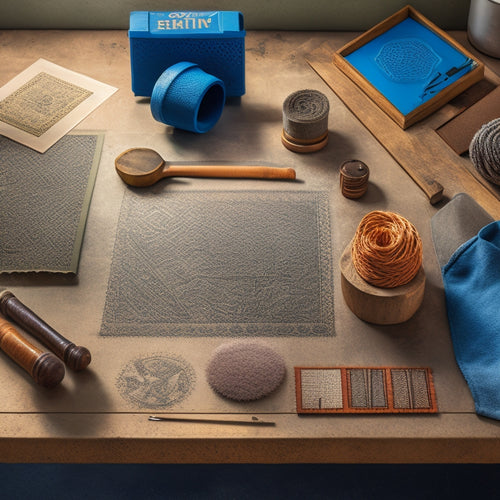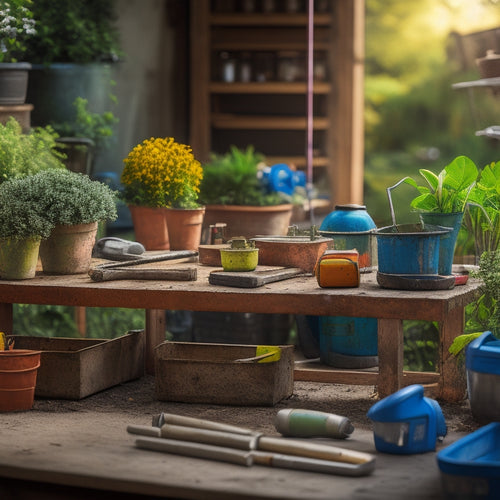
Concrete Hand Tools for a Perfect Mix Every Time
Share
You need a precise set of concrete hand tools to guarantee a perfect mix every time, as the right tools can mean the difference between a strong, durable concrete structure and one that's prone to cracking and deterioration. Start with a sturdy mixing bucket that can withstand repeated use and harsh environments. Then, choose the right mixing and blending tools, such as trowels, shovels, and mixing sticks, and follow proper blending techniques to achieve a consistent mix. With the right tools and techniques, you'll be well on your way to achieving a high-quality concrete mix; now, discover the specific tools and methods that will take your concrete projects to the next level.
Key Takeaways
• Sturdy mixing buckets with non-slip bases and durable materials ensure a consistent mix and prevent accidents.
• Mixing tools like trowels, shovels, and mixing sticks, along with personal protective equipment, aid in achieving a perfect mix.
• Clean mixing areas, correct sequencing of ingredients, and proper blending ratios are essential for uniform mixing and high-quality concrete.
• Tamping and finishing tools, such as tampers and tamping rods, help compact concrete and remove air pockets for a smooth finish.
• Measuring cups with clear markings and pouring spouts enable accurate measurements and smooth pouring, contributing to a perfect mix.
Mixing Bucket Essentials
When preparing to mix concrete, you'll need a sturdy mixing bucket that can withstand the rigors of repeated use and harsh construction environments. A reliable mixing bucket is vital for achieving a consistent mix, and it's important to choose the right one for the job.
Consider the size of the mixing bucket, as it will directly impact the amount of concrete you can mix at one time. Common mixing bucket sizes range from 1-5 gallons, with 2-3 gallon buckets being the most popular among professionals.
The material type of the bucket is also significant. You'll want a bucket made from a durable, rust-resistant material like steel or heavy-duty plastic. Avoid buckets with thin walls or weak handles, as they can compromise the structural integrity of the bucket.
Additionally, look for buckets with a non-slip base to prevent accidents and spills. By selecting the right mixing bucket, you'll be well on your way to achieving a perfect mix every time.
Tamping and Finishing Tools
With your mixing bucket and ingredients ready, you're now prepared to shape and smooth your freshly mixed concrete using tamping and finishing tools.
At this stage, it's essential to guarantee a uniform, even surface to achieve a professional finish. Tamping techniques involve using tools to compact and consolidate the concrete, removing air pockets and excess water. A tamper or tamping rod is indispensable for this process, allowing you to apply the necessary pressure without damaging the surrounding surface.
For finishing methods, you'll need a range of tools to achieve the desired texture and appearance. A finishing trowel is a must-have for smoothing and flattening the concrete, while a float or darby helps to remove excess material and create a uniform surface. Edgers and jointers are also critical for creating clean, defined edges and joints.
By mastering these tamping techniques and finishing methods, you'll be able to produce a high-quality, professional-looking finish that's both durable and aesthetically pleasing.
Remember to always follow safety guidelines and best practices when working with concrete to guarantee a safe and successful project.
Measuring and Pouring Aids
You'll need to accurately measure and pour the concrete mixture to achieve the desired shape and form, making measuring and pouring aids essential tools in your concrete hand tool arsenal. These tools guarantee you're working with the right proportions, which is critical for a strong and durable final product.
Measuring cups are a must-have for precise measurements. Look for cups with clear markings and a sturdy design that can withstand the rigors of heavy use.
When it's time to pour, pouring spouts can help you achieve a smooth, even flow. These spouts fit onto the end of your mixing bucket, allowing you to direct the concrete mixture exactly where you need it. This reduces waste, prevents messes, and makes the entire process safer.
Mixing and Blending Tools
When you're working with concrete, getting the mix just right is vital, and that's where your mixing and blending tools come in.
You'll need to choose the right tool for the job, whether it's a trowel, shovel, or mixing stick, and understand the best techniques for blending your materials.
Mixing Tool Options
Select from a range of mixing tool options to efficiently blend and mix concrete, including tamping tools, mixing sticks, and mixing paddles.
When choosing a mixer type, consider the mixing method you'll be using. For instance, if you're mixing small batches, a manual mixing paddle or stick might be sufficient. However, for larger batches or more complex mixes, you may need a mechanical mixer, such as a drill-mounted mixer or a walk-behind mixer.
Remember to always follow the manufacturer's instructions for the specific mixer type you're using.
Additionally, make certain you're wearing proper personal protective equipment, such as gloves and safety glasses, to prevent injuries.
When mixing, maintain a firm grip on the tool and keep your body positioned at a safe distance from the mixing area. This will help prevent accidents and make certain a smooth mixing process.
Blending Techniques Matter
With the right mixing tool in hand, it's time to focus on the blending techniques that'll help you achieve a consistent, high-quality concrete mix. You're about to reveal the secrets to a perfect blend, every time.
When it comes to blending techniques, you'll want to pay attention to your mixing methods and blending ratios.
Here are some key takeaways to keep in mind:
-
Start with a clean slate: Make certain your mixing area is free from debris and contaminants to prevent defects in your concrete.
-
Mix in the right order: Add ingredients in the correct sequence to prevent segregation and make certain a uniform mix.
-
Use the right blending ratio: Achieve the perfect balance of cement, aggregate, and water to guarantee a strong, durable concrete.
- Don't overmix: Stop mixing once the ingredients are fully incorporated to prevent excessive heat buildup and weakened concrete.
Material Handling Essentials
You'll need a range of specialized tools to handle and blend concrete materials efficiently and effectively.
When it comes to material handling, you can't afford to compromise on quality or safety. That's why investing in the right mixing and blending tools is essential. From shovels and trowels to mixing buckets and paddles, each tool plays a critical role in ensuring a perfect mix every time.
Proper material handling techniques are just as important as the tools themselves. Make sure you're using the correct lifting and pouring methods to avoid accidents and injuries.
Keep your equipment storage area organized and easily accessible to minimize downtime and maximize productivity. A well-maintained storage space also helps prevent equipment damage and extends the lifespan of your tools.
Concrete Smoothing Tools
For achieving a smooth, even finish, concrete smoothing tools are essential, as they remove imperfections and leave the surface ready for further processing or final application.
When it comes to smoothing techniques, you'll need the right tools to get the job done efficiently and safely.
Here are the top concrete smoothing tools you'll need in your arsenal:
-
Tamping tools: Used to remove air pockets and excess water from the surface, ensuring a smooth finish.
-
Floats: Designed to level and smooth the concrete, removing imperfections and creating a uniform surface.
-
Trowels: Essential for applying and spreading concrete, as well as smoothing out small areas.
- Edgers: Help create a clean, defined edge around the perimeter of the concrete surface.
Edging and Jointing Tools
When you're working with edging and jointing tools, you'll find that achieving clean edges and controlling joint spacing are vital aspects of the process.
You'll want to guarantee that your edges are smooth and well-defined, as this will greatly impact the final appearance of your concrete project.
Clean Edges Matter
As you work on a concrete project, achieving clean edges is essential to the final product's appearance and durability. Clean edges not only enhance the visual appeal of your project but also guarantee edge durability and alignment. To achieve this, you'll need the right edging and jointing tools.
Here are some essential tools to get the job done:
-
Edging trowels: These tools help create a clean, rounded edge that's resistant to chipping and cracking.
-
Jointing chisels: Use these to remove excess concrete and create a smooth, even joint.
-
Edging floats: These tools help to smooth and shape the concrete edge, guaranteeing a clean finish.
- Jointing knives: These are used to cut and shape the concrete joints, guaranteeing a precise fit.
Joint Spacing Control
You'll need to maintain precise control over joint spacing to guarantee your concrete project meets structural and aesthetic requirements. Incorrect joint spacing can lead to cracking, weakening the structure, and compromising its integrity. To avoid these issues, it's vital to master joint spacing techniques and achieve ideal joint placement.
Edging and jointing tools are fundamental for achieving precise joint spacing control. Edgers, such as joint cutters and jointers, help create clean, defined joints, while jointing tools, like joint tamping tools and joint finishing tools, guarantee proper spacing and alignment. These tools enable you to control the width and depth of joints, ensuring they're evenly spaced and properly aligned.
When choosing edging and jointing tools, prioritize quality and durability. Look for tools with sturdy construction, ergonomic handles, and high-carbon steel blades that can withstand the demands of concrete work. By investing in the right tools and honing your joint spacing techniques, you'll be able to achieve professional-grade results that meet both structural and aesthetic standards.
Safety and Protection Gear
Regularly, concrete workers wear personal protective equipment (PPE) to minimize exposure to hazardous materials and reduce the risk of injury. You should prioritize your safety by investing in the right safety gear and protective equipment. This is vital when working with concrete, as it can be harsh on your skin and eyes.
Here are some essential safety items you should always have:
-
Safety goggles: Protect your eyes from concrete splashes and debris.
-
Dust mask: Prevent inhalation of concrete dust and other airborne particles.
-
Gloves: Shield your hands from harsh chemicals and rough concrete surfaces.
- Steel-toed boots: Safeguard your feet from heavy objects and tools.
Cleanup and Maintenance Tools
Cleanup and Maintenance Tools
With your safety gear in place, you're ready to tackle the job, and that includes having the right tools to clean up and maintain your workspace and equipment. Cleanup techniques are essential to prevent concrete from hardening on your tools and equipment, making them difficult to use and maintain. A well-maintained workspace also reduces the risk of accidents and injuries.
Here are some essential cleanup and maintenance tools to have:
| Tool | Purpose |
|---|---|
| Wire brush | Remove dried concrete from tools and equipment |
| Pressure washer | Clean large areas and equipment quickly and efficiently |
| Cleaning solvent | Dissolve and remove concrete residue from tools and surfaces |
| Tool lubricant | Keep tools well-lubricated to prevent rust and corrosion |
Frequently Asked Questions
Can I Use Concrete Hand Tools for Other Construction Materials?
When working with various construction materials, you're likely wondering if your concrete hand tools are compatible.
The good news is that many tools can be used across different materials, offering material versatility.
However, it's essential to verify the tool is designed for the specific material you're working with to avoid damage or safety risks.
Always check the manufacturer's guidelines to confirm tool compatibility and take necessary precautions to assure a safe and successful project.
How Often Should I Clean and Maintain My Concrete Tools?
You should clean and maintain your concrete tools regularly to guarantee peak performance and safety.
Aim for daily cleaning after each use, and perform thorough maintenance every week.
Check for wear and tear, rust, or damage, and replace parts as needed.
A consistent cleaning frequency and proper tool maintenance will prevent accidents, prolong tool lifespan, and assure a perfect mix every time.
Are All Concrete Hand Tools Suitable for DIY Projects?
When tackling DIY projects, you need to choose the right tools for the job. Not all concrete hand tools are suitable for DIY projects, so it's essential to select the right ones.
Look for tools made from suitable materials that can withstand the demands of concrete work. Your tool selection will impact the quality of your project, so don't compromise on durability and performance.
Make informed choices to guarantee a safe and successful project outcome.
Can I Mix Concrete by Hand for Large Construction Projects?
You're wondering if you can mix concrete by hand for large construction projects. Honestly, it's not recommended.
You'll be putting yourself and others at risk of injury from fatigue, and the quality of the mix will likely suffer.
For large projects, it's essential to use mechanical mixers and ideal mixing techniques to guarantee consistency and strength.
Leave the manual mixing for small DIY projects, and prioritize safety and efficiency for big jobs.
Are Concrete Hand Tools Durable Enough for Heavy Use?
You're wondering if concrete hand tools can withstand heavy use. The answer lies in the tool material durability.
Look for tools made from high-quality, heavy-duty materials like forged steel or durable polymers. These can handle professional usage expectations, ensuring your safety on the job site.
Don't settle for flimsy tools that can break or fail, putting you at risk. Choose tools built to last, and you'll be mixing concrete like a pro in no time.
Conclusion
Now that you've got the right concrete hand tools, it's time to 'hammer out' the perfect mix every time.
With these essentials, you'll be well-equipped to tackle any concrete project that comes your way.
Remember, having the right tools is half the battle - the other half is using them correctly.
Practice makes perfect, so get mixing and don't be afraid to get your hands dirty.
Related Posts
-

5 Best Tools for Stamping Concrete Walls
When it comes to stamping concrete walls, you'll need a range of specialized tools to achieve the desired texture and...
-

Free Design Tools for Concrete House Planning
You can kick-start your concrete house planning project without breaking the bank, as there are several free design t...
-

Must-Have Tools for Concrete Planter Projects
As you commence your concrete planter project, you'll need a range of specialized tools to achieve professional-grade...


